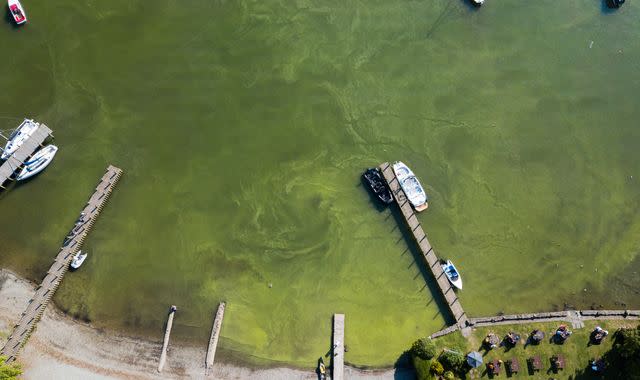Tourist numbers turning Lake Windermere green, researchers say

The flood of tourists to the Lake District is turning Lake Windermere green by driving algal blooms, according to new research.
The study - funded by the UK Space Agency - is believed to be the first to examine the impact of visitor numbers on the ecology of the lake in Cumbria.
Algal blooms are fuelled by high levels of nutrients - which can come from sewage - and high temperatures.
They can make the water toxic or starve wildlife of oxygen.
The Save Windermere campaign group, which helped organise the study, said it showed a "direct correlation" between the number of visitors and algal blooms.
"With a clear link between human activity and algal growth, action is imperative," said Matt Staniek, founder of Save Windermere.
"Save Windermere is calling for complete removal of all sewage from Windermere."
United Utilities has released more than 27,000 hours of untreated sewage since 2020, according to Save Windermere's analysis of Environment Agency (EA) data.
Water companies can legally do this in emergencies to prevent sewage backing up elsewhere, but the proliferation of discharges has raised questions about whether they are doing this routinely.
The EA also permits some treated effluent to be discharged, which - although it has been cleaned - is still high in nutrients from human waste and detergents.
Lake Windermere is the largest in England, while the Lake District attracts around 18 million visitors a year, according to the national park.
As part of the study, research company Map Impact analysed mobile phone data to estimate the number of people in the area, alongside levels of chlorophyll-a - an indicator for algae - detected.
The researchers identified single days when more than 300,000 people were in the area - compared with the resident population of just 35,000.
They said they also found a link with high temperatures, with a more intense bloom in the hot weather of 2022, despite lower than usual visitor numbers.
Climate change has already warmed the UK by about 1C since around the 1950s, driving longer and more frequent hot spells, according to the Met Office.
Richard Flemmings, chief executive of Map Impact, said the research showed how "technology can play a vital role in understanding pollution sources and how to mitigate them".
Read more from Sky News:
'Shocking' incidents of sewage spewing into gardens
Spills of raw sewage into England's rivers and seas are worst on record
Hundreds of water voles reintroduced to Lake District after near wipe-out
United Utilities said its infrastructure can cope with peak visitor numbers, adding: "Our wastewater treatment works are sized to treat the sewage from maximum population numbers at peak times, and use the highest treatment standards including phosphorus removal and UV treatment to kill bacteria."
An Environment Agency spokesperson said: "Windermere is affected by pollution from a range of different sources, including sewage discharges from waste water treatment works, storm overflows, septic tanks and road and agricultural run-off.
"Recent data shows a 30% reduction in phosphorus - which can lead to algal blooms - entering the lake since 2020, and the lake's bathing waters were rated 'excellent' in 2023, but we know there is more to do.
"We are absolutely committed to improving the water quality in Lake Windermere. That is why we are working closely with the local community and a range of partners to reduce pollution from all sources as well as reviewing wastewater treatment works permits within the Windermere catchment."

 Yahoo News
Yahoo News 
